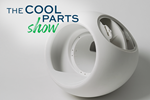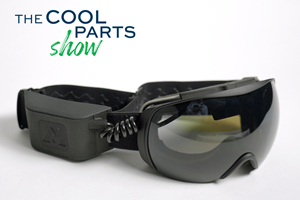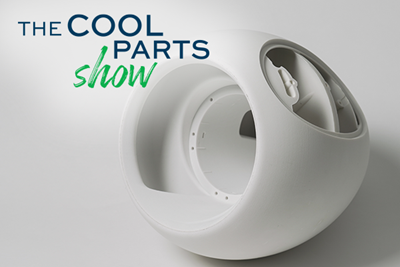Multiple options exist for the audiophile seeking to improve the sound from a speaker, including spikes that aim to limit vibration by separating the cabinet from the surface below it (which may or may not work all that well, depending on the vibration frequency) and resonance compensators that seek to absorb vibration. In a previous episode of The Cool Parts Show, we spoke with Günter Kappler, a mechanical engineer who has developed 3D printed metal bellows. Here, Kappler shares how he applied the lessons learned from printing those flexible bellows to creating these ductile spikes. The devices borrow from conventional spikes, coming to a point to limit the contact between the speaker and the floor, but also offer flexibility to help isolate the speaker and damp vibration. | This episode of The Cool Parts Show brought to you by Carpenter Additive
The Cool Parts Show is a video series from Additive Manufacturing Media that explores the what, how and why of unusual 3D printed parts. Watch more here.
Have a cool part to share? Email us.
Related Resources
- Günter Kappler Engineering
- Our previous episode on 3D printed metal bellows
- Another Cool Parts episode dealing with audio equipment (in this case, the speaker cabinet itself)
Transcript
00:00:08:23 - 00:00:09:23
Pete Zelinski
I'm Pete.
00:00:09:23 - 00:00:10:18
Stephanie Hendrixson
I'm Stephanie.
00:00:10:18 - 00:00:13:01
Pete Zelinski
Welcome to a bonus episode of The Cool Parts Show.
00:00:13:01 - 00:00:40:07
Stephanie Hendrixson
This is a follow up to an episode that we posted recently about these 3D printed metal bellows. We talked to Günter Kappler, who's been working on how to use laser power bed fusion to recreate flexible bellows like this. So conventional bellows like this one are typically made through a tooling-based process which puts some limitations on the geometries and the different variables. And so moving to 3D printing would allow for greater design freedoms and more customizability for flexible parts like this.
00:00:40:07 - 00:01:07:18
Pete Zelinski
So we did that whole episode on 3D printed metal bellows Go check it out. We'll put a link in the show description. But in the course of figuring all this out, the right geometry, the right orientation during the build, Gunter also realized that this idea, 3D printing for solid flexible structures, it potentially has other applications as well for uses including stereo equipment.
00:01:07:18 - 00:01:19:17
Stephanie Hendrixson
These little ductile spikes. So these are basically like little feet that you would put under a speaker or another piece of audio equipment. and there are a couple of thoughts or theories or reasons that you might want to use a device like this.
00:01:19:17 - 00:02:05:04
Pete Zelinski
So here is the challenge he's potentially solving, isolating vibrating stereo speakers from other hard surfaces. There are a couple of options. There are spikes that minimize the contact area between the speaker and the floor or table surface underneath it. That may or may not reduce vibration depending on the vibration frequency. There are also what are called resonance compensators. These are basically flexible padding to put underneath the speaker. This combines both. This 3D printed spike also has this bellows form that brings flexibility. So it's a spike with that resonance compensation kind of built in.
00:02:05:04 - 00:02:40:05
Stephanie Hendrixson
So Gunter was able to take some of the lessons learned in developing and 3D printing these larger metal bellows and apply them to the ductile spikes. So orientation is one of those things. So printing these spikes at an angle on this corner so you avoid support structures and make them easier to produce. And then choosing a non-round profile for these sort of like bellows-like ridges here was important for allowing the flexibility. And so you end up with something that looks kind of like a ductile spike has a point on the end, but it's more flexible, similar to the resonance compensator.
00:02:40:05 - 00:03:11:16
Dr. Günter Kappler
Nowadays there are two concepts. On the one hand, there are spikes that transfer vibrations to the floor. On the other hand, there are rubber resonance compensators that absorb the vibrations. The idea of the ductile spikes is to combine both. To absorb the vibrations with the help of the bellows and transfer them to the floor. This is realized with a trapezoidal bellows, one end of which ends in a spike. On the other side, the bellows goes directly into a thread that is screwed into the loudspeaker.
00:03:11:16 - 00:03:52:16
Pete Zelinski
So these are plastic made through a deposition 3D printing process, FDM or FFF. Ultimately they would be 3D printed in metal. But what I love about this is the universality of this idea. Single piece flexible forms and the shape necessary to realize this and the orientation by mounting them on a corner at an angle for the build. Just as you said, it results in a form where there's no surface in need of support. And even the point of the spike is in this pyramid shape so that it's the same. Nothing is more than 45 degrees, so no support structures needed.
00:03:52:16 - 00:04:19:20
Stephanie Hendrixson
Yes, it's kind of neat that some of the lessons from laser powder bed fusion apply for FFF and when these ultimately going to be made in metal, it'll kind of work in the reverse, too. So these ductile spikes are in kind of early stages. Günter is working with an acoustic laboratory to further develop this idea. But it's a really neat continuation of the lessons he's already learned about 3D printing flexible metal components, and I'm sure there are other applications we'll find as well going forward.
00:04:19:20 - 00:04:30:00
Dr. Günter Kappler
This is a new approach and I'm really excited to see how it evolves. And it's also a nice inspiration for what else you can do with 3D printed bellows.
Related Content
This Drone Bird with 3D Printed Parts Mimics a Peregrine Falcon: The Cool Parts Show #66
The Drone Bird Company has developed aircraft that mimic birds of prey to scare off problem birds. The drones feature 3D printed fuselages made by Parts on Demand from ALM materials.
Read More8 Cool Parts From RAPID+TCT 2022: The Cool Parts Show #46
AM parts for applications from automotive to aircraft to furniture, in materials including ceramic, foam, metal and copper-coated polymer.
Read MoreRekkie AR Ski Goggles Made Possible With 3D Printing: The Cool Parts Show #53
When the electronics enclosure key to these AR goggles proved difficult to mold, 3D printing allowed the inventors to keep the complexity — while also making improvements for assembly and user experience.
Read MoreAircraft Ducts 3D Printed in Composite Instead of Metal: The Cool Parts Show #68
Eaton’s new reinforced PEKK, tailored to aircraft applications, provides a cheaper and faster way to make ducts compared to formed aluminum.
Read MoreRead Next
8 Cool Parts From Formnext 2021: The Cool Parts Show #36
The world’s leading trade show for industrial 3D printing returned as an in-person event. Among all the additive manufacturing technology showcased at the show, we also found our most amazing batch of cool parts so far.
Read MoreHi-Fi 3D Printed Speaker Cabinet: The Cool Parts Show #29
The Hylixa high-fidelity speaker has an internal geometry and footprint designed for optimal sound that could only be realized through 3D printing. How Node Audio developed and produces this product.
Read More3D Printed Speaker Cabinet Delivers Big Sound in a Small Footprint
Node Audio’s Hylixa high-fidelity speaker takes advantage of selective laser sintering (SLS) 3D printing to achieve a compact construction with an uncompromised sound range.
Read More

.jpg;width=70;height=70;mode=crop)













